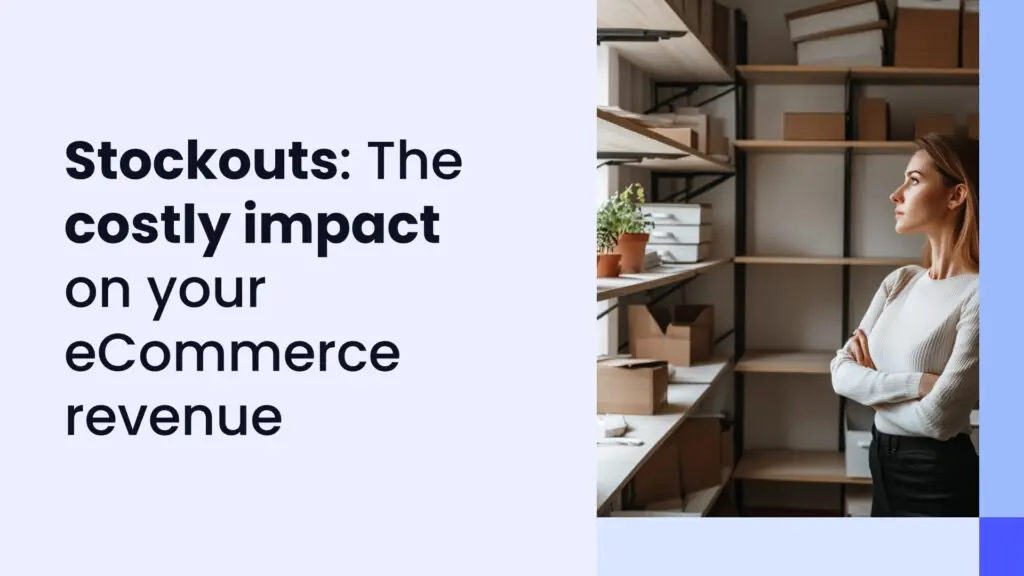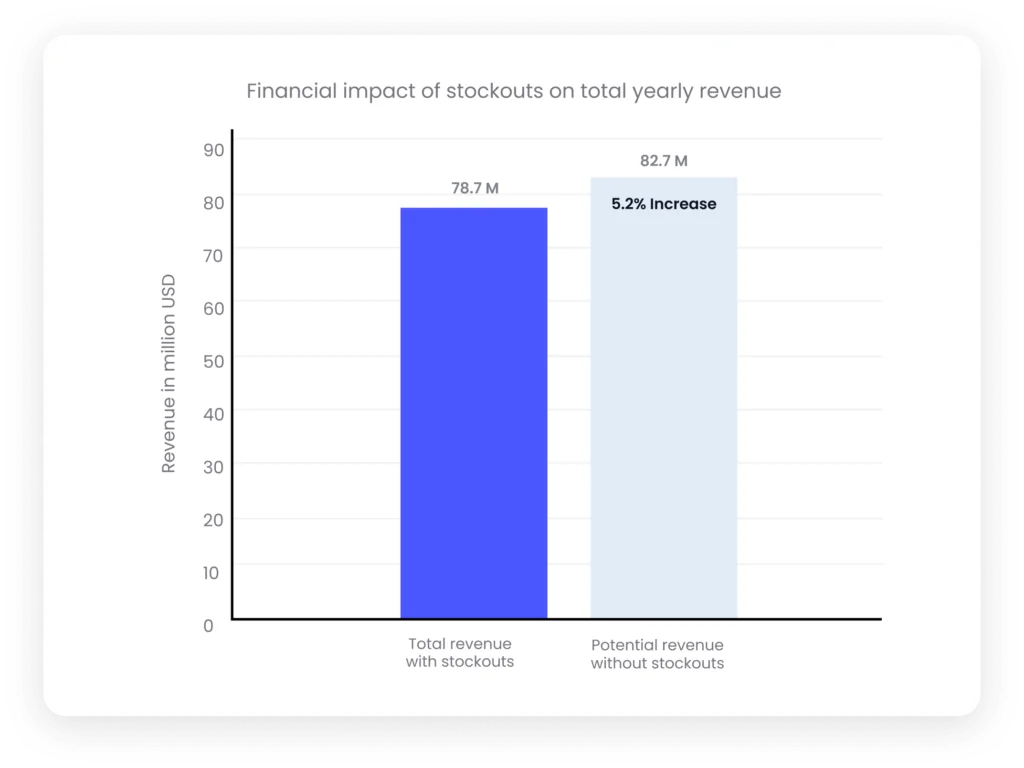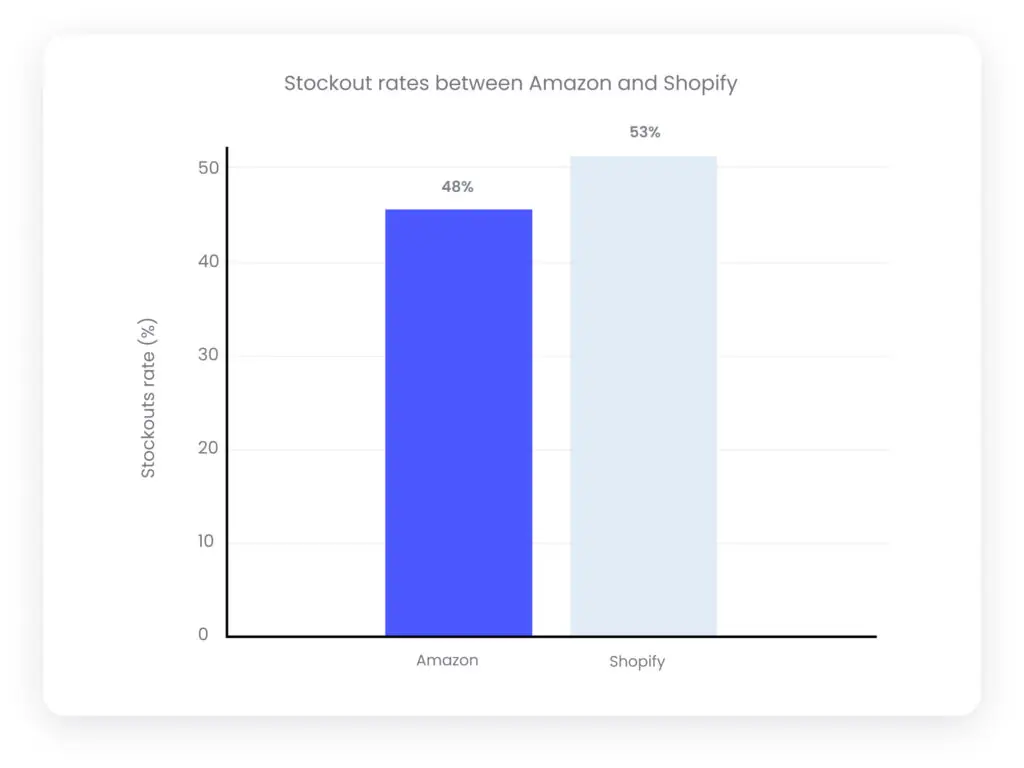The hidden cost of stockouts: A data-driven analysis showing how missing inventory impacts your eCommerce revenue

In the fast-paced world of eCommerce, managing inventory efficiently is crucial to sustaining growth and maximizing revenue. One of the most significant challenges eCommerce businesses face is dealing with stockouts – short and long periods when products are unavailable for purchase.
Stockouts can severely impact a business’s bottom line, leading to lost sales, dissatisfied customers, and a tarnished brand reputation.
We conducted a comprehensive analysis together with our trusted partners and 7-figure sellers at DAVAN Strategic to understand the prevalence and financial implications of stockouts among eCommerce companies.
Understanding stockouts
A stockout occurs when an item is out of stock and unavailable for customers to purchase. This situation arises when the demand for a product exceeds its available inventory, leading to missed sales opportunities. Stockouts can be caused by various factors, including inaccurate demand forecasting, supply chain disruptions, or delays in inventory replenishment.
For eCommerce businesses, stockouts not only result in immediate revenue loss – they can also have long-term effects on customer satisfaction and loyalty. Moreover, stockouts can lead to your business dropping in organic rank for search results; regaining that rank could take considerable time and effort once the product actually comes back in stock.
The analysis – overview
We examined 524 products from 169 Amazon and Shopify sellers, each generating a yearly revenue of at least $100,000 USD. The research focused on products with median sales of at least seven units per day to ensure the data’s relevance and accuracy.
A ‘stockout’ was defined as a period of seven or more consecutive days with zero revenue, indicating that the product was likely unavailable for purchase during that time.
Key findings
The analysis uncovered several important trends and patterns related to stockouts in eCommerce. These findings provide a comprehensive understanding of how often stockouts occur, their impact on revenue, and how different platforms compare in managing inventory. Using these results and the prominent areas they showcase, you can learn what to focus on and improve in order to make meaningful changes in your business.
1. Prevalence of stockouts
The analysis revealed that stockouts are certainly a common issue among eCommerce businesses:
- 51% of the 524 products analyzed experienced at least one stockout period.
- This means that over half of the products faced periods where they were unavailable for purchase, highlighting a widespread issue in inventory management.

This high incidence underscores the challenges eCommerce businesses face in maintaining consistent inventory levels. Whether due to unexpected spikes in demand, supply chain disruptions, or inadequate inventory management practices – stockouts remain a significant hurdle.
2. Financial implications
The financial impact of stockouts is substantial:
- The total yearly revenue across all products was $78.7 million.
- If stockouts had been avoided, this revenue could have increased to $82.7 million, representing a potential revenue boost of $4 million or 5.2%.
This data highlights the critical role that effective inventory management plays in maximizing revenue. A 5.2% increase in revenue can be a game-changer for many businesses, translating to significant growth opportunities and improved profitability.

3. Duration of stockouts
The duration of stockouts further emphasizes their detrimental impact on your business:
- The average number of stockout days for the 267 products that experienced stockouts was 35 days – equivalent to over a month of lost sales opportunities.
Extended periods of unavailability not only result in significant revenue loss, but can also erode customer loyalty and damage brand reputation. Customers who encounter out-of-stock products may turn to your competitors, leading to a loss of market share.
Average number of stockout days per year for products that went out of stock = over a month of lost sales.
4. Platform-specific insights
The analysis also compared stockout rates between two major eCommerce platforms – Amazon and Shopify:
- Amazon: 48% of products experienced stockouts.
- Shopify: 53% of products experienced stockouts.
The slightly higher stockout rate on Shopify suggests that platform-specific challenges and opportunities for improvement exist. While both platforms face similar issues, the nuances in their inventory management capabilities and seller practices may influence these rates, which is definitely something you should consider.

Might also interest you:
- Stockouts cause a costly chain reaction to eComm stores. Here’s how to prevent them.
- How and why running out of stock hurts your Amazon ranking
- The comprehensive guide to cash flow management for eCommerce sellers
Impact on revenue and customer experience
Stockouts disrupt immediate sales but they also have far-reaching consequences on revenue and customer satisfaction that you may not think of initially. This section delves into how stockouts affect both the financial health of eCommerce businesses and the overall customer experience, highlighting the importance of effective inventory management for your business.
1. Revenue loss
The financial implications of stockouts are multifaceted. Beyond the immediate loss of sales, stockouts can lead to reduced customer lifetime value (CLV). Customers who encounter stockouts may be less likely to return to your store for future purchases.
Additionally, stockouts can disrupt marketing efforts – promotions and advertising campaigns lose their effectiveness when advertised products are unavailable. It is important to note, however, that some ad types on Amazon will automatically stop running once a product goes out of stock.
2. Customer experience
Like we’ve seen with other areas, stockouts can also negatively impact the customer experience. When customers can’t find the products they want, it leads to frustration and disappointment. This dissatisfaction can result in negative reviews and a damaged brand reputation.
In a highly competitive eCommerce landscape, maintaining a positive customer experience is crucial for retaining your customers and fostering brand loyalty.
3. Lost rankings
Running out of stock leads to immediate revenue loss which weakens your customer base, but it can also negatively affect your product rankings on the different eCommerce platforms. For Amazon sellers, stockouts can result in a drop in search rankings, making it harder for customers to find your products.
Regaining lost rankings can be a costly and time-consuming process, involving increased advertising spend and promotional efforts to rebuild your visibility and sales momentum.
How to mitigate stockouts: Strategies for success
To alleviate the impact of stockouts, you can adopt several proactive strategies:
1. Enhanced demand forecasting
Utilize advanced analytics and machine learning to predict demand more accurately. By analyzing historical sales data, market trends, and seasonal fluctuations, you’ll be able to better anticipate inventory needs.
2. Supplier collaboration
Work on strengthening relationships with suppliers to ensure timely replenishments. Collaborative planning and transparent communication with suppliers can help mitigate supply chain disruptions and reduce lead times.
3. Inventory buffer
Maintain a buffer stock to cushion against unexpected demand spikes. While holding extra inventory can incur carrying costs, the benefits of preventing stockouts often outweigh these expenses.
4. Diversified sourcing
Consider sourcing products from multiple suppliers to reduce dependency on a single source. Diversifying the supply chain can provide flexibility and reduce the risk of your business being exposed to stockouts due to supplier issues.
5. Technology integration
Implement inventory management software to streamline stock monitoring and ordering processes. Automated systems can provide real-time visibility into inventory levels, trigger reorder alerts, and optimize stock levels.
Conclusion
It’s no secret that stockouts present a serious challenge for eCommerce businesses, with the potential to severely impact revenue and customer satisfaction. The findings from our collaborative analysis with DAVAN Strategic highlight the importance of preventing stockouts in order to maximize revenue and maintain customer loyalty.
For eCommerce sellers, particularly those on platforms like Amazon and Shopify, investing in advanced inventory management solutions is essential. By addressing the root causes of stockouts and leveraging data-driven insights, you can enhance your operational efficiency, safeguard your brand’s reputation, and drive sustainable growth.
To avoid the costly impact of stockouts and ensure your inventory is always ready to meet customer demand, connect your store with 8fig today. Our tailored funding solutions and advanced inventory management support can help you maintain optimal stock levels, enhance operational efficiency, and boost your revenue.
About DAVAN Strategic
DAVAN Strategic, created by David Lang and Ryan Sherrard, is a leading analytics and strategy consulting firm specializing in eCommerce solutions. With a focus on leveraging data to drive business growth, DAVAN Strategic partners with companies to optimize their inventory management and boost their revenue.
Have article ideas, requests, or collaboration proposals? Reach out to us at editor@8fig.co – we’d love to hear from you.
- 14 strategies to improve your eCommerce business’s financial health
- New technologies that are changing the eCommerce fashion industry – everything you need to know
- Why just-in-time funding is the future for eCommerce
- BFCM: The ultimate guide to eCommerce sales [2024]
- 7 reasons successful eCommerce sellers opt for funding to fuel growth instead of relying on profits
to our blog
Read the latest
from 8fig

Laura El, founder of Stellar Villa, shares 8 key strategies that helped her scale her art brand – from viral pet portraits to a thriving eCommerce business.

Keeping your startup team inspired can feel like a challenge, especially on a tight budget. This article by Dario Markovic and Eric Javits explores practical, affordable strategies to motivate your team.

Fintech is revolutionizing the shopping experience, making transactions faster, safer, and more accessible. Learn how these innovations are shaping the future of eCommerce and helping businesses grow globally.